Exhibit 99.4
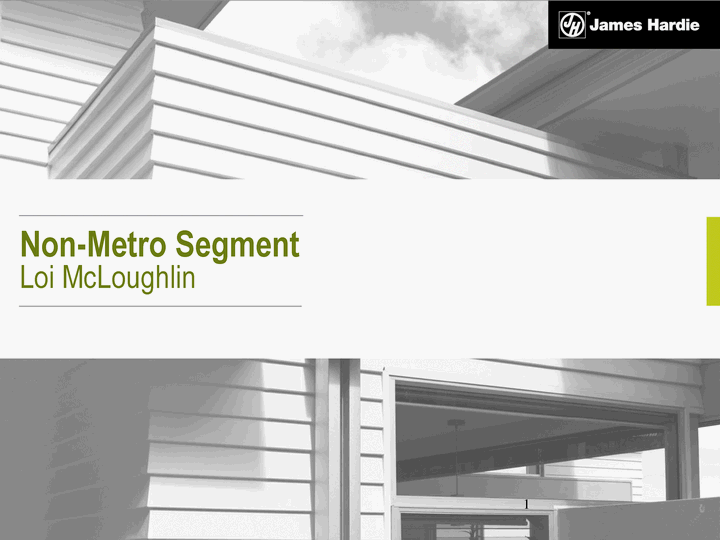
| Non-Metro Segment Loi McLoughlin 1 |

| Non-Metro Segment Loi McLoughlin 1 |
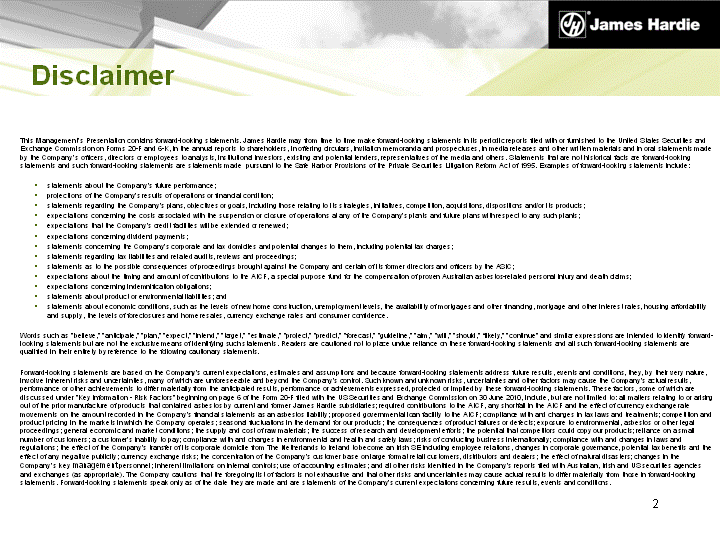
| Disclaimer This Management's Presentation contains forward-looking statements. James Hardie may from time to time make forward-looking statements in its periodic reports filed with or furnished to the United States Securities and Exchange Commission on Forms 20-F and 6-K, in the annual reports to shareholders, in offering circulars, invitation memoranda and prospectuses, in media releases and other written materials and in oral statements made by the Company's officers, directors or employees to analysts, institutional investors, existing and potential lenders, representatives of the media and others. Statements that are not historical facts are forward-looking statements and such forward-looking statements are statements made pursuant to the Safe Harbor Provisions of the Private Securities Litigation Reform Act of 1995. Examples of forward-looking statements include: statements about the Company's future performance; projections of the Company's results of operations or financial condition; statements regarding the Company's plans, objectives or goals, including those relating to its strategies, initiatives, competition, acquisitions, dispositions and/or its products; expectations concerning the costs associated with the suspension or closure of operations at any of the Company's plants and future plans with respect to any such plants; expectations that the Company's credit facilities will be extended or renewed; expectations concerning dividend payments; statements concerning the Company's corporate and tax domiciles and potential changes to them, including potential tax charges; statements regarding tax liabilities and related audits, reviews and proceedings; statements as to the possible consequences of proceedings brought against the Company and certain of its former directors and officers by the ASIC; expectations about the timing and amount of contributions to the AICF, a special purpose fund for the compensation of proven Australian asbestos-related personal injury and death claims; expectations concerning indemnification obligations; statements about product or environmental liabilities; and statements about economic conditions, such as the levels of new home construction, unemployment levels, the availability of mortgages and other financing, mortgage and other interest rates, housing affordability and supply, the levels of foreclosures and home resales, currency exchange rates and consumer confidence. Words such as "believe," "anticipate," "plan," "expect," "intend," "target," "estimate," "project," "predict," "forecast," "guideline," "aim," "will," "should," "likely," "continue" and similar expressions are intended to identify forward- looking statements but are not the exclusive means of identifying such statements. Readers are cautioned not to place undue reliance on these forward-looking statements and all such forward-looking statements are qualified in their entirety by reference to the following cautionary statements. Forward-looking statements are based on the Company's current expectations, estimates and assumptions and because forward-looking statements address future results, events and conditions, they, by their very nature, involve inherent risks and uncertainties, many of which are unforeseeable and beyond the Company's control. Such known and unknown risks, uncertainties and other factors may cause the Company's actual results, performance or other achievements to differ materially from the anticipated results, performance or achievements expressed, projected or implied by these forward-looking statements. These factors, some of which are discussed under "Key Information - Risk Factors" beginning on page 6 of the Form 20-F filed with the US Securities and Exchange Commission on 30 June 2010, include, but are not limited to: all matters relating to or arising out of the prior manufacture of products that contained asbestos by current and former James Hardie subsidiaries; required contributions to the AICF, any shortfall in the AICF and the effect of currency exchange rate movements on the amount recorded in the Company's financial statements as an asbestos liability; proposed governmental loan facility to the AICF; compliance with and changes in tax laws and treatments; competition and product pricing in the markets in which the Company operates; seasonal fluctuations in the demand for our products; the consequences of product failures or defects; exposure to environmental, asbestos or other legal proceedings; general economic and market conditions; the supply and cost of raw materials; the success of research and development efforts; the potential that competitors could copy our products; reliance on a small number of customers; a customer's inability to pay; compliance with and changes in environmental and health and safety laws; risks of conducting business internationally; compliance with and changes in laws and regulations; the effect of the Company's transfer of its corporate domicile from The Netherlands to Ireland to become an Irish SE including employee relations, changes in corporate governance, potential tax benefits and the effect of any negative publicity; currency exchange risks; the concentration of the Company's customer base on large format retail customers, distributors and dealers; the effect of natural disasters; changes in the Company's key management personnel; inherent limitations on internal controls; use of accounting estimates; and all other risks identified in the Company's reports filed with Australian, Irish and US securities agencies and exchanges (as appropriate). The Company cautions that the foregoing list of factors is not exhaustive and that other risks and uncertainties may cause actual results to differ materially from those in forward-looking statements. Forward-looking statements speak only as of the date they are made and are statements of the Company's current expectations concerning future results, events and conditions. 2 |
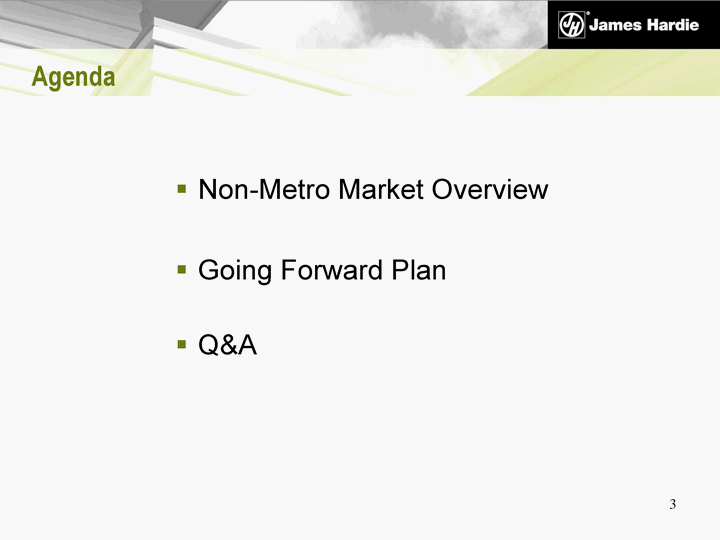
| Agenda 3 Non-Metro Market Overview Going Forward Plan Q&A |
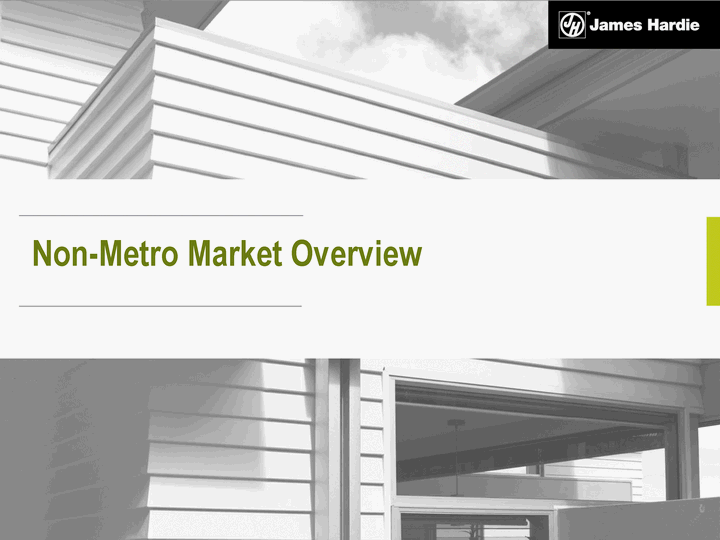
| Non-Metro Market Overview |
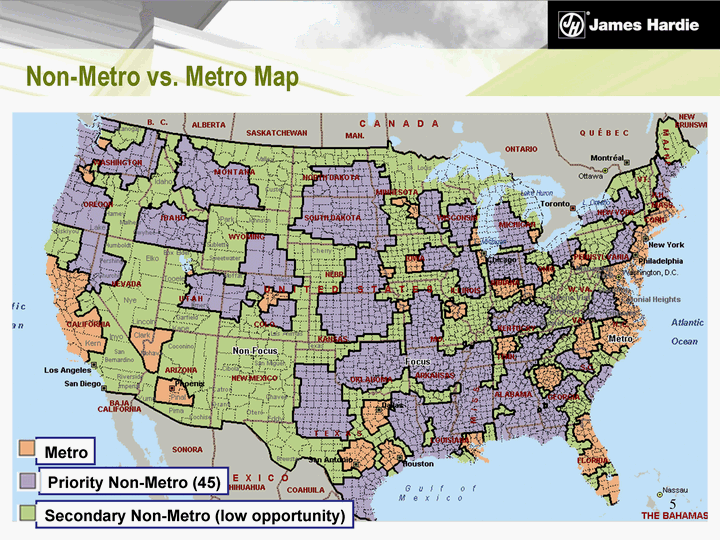
| Non-Metro vs. Metro Map 5 Priority Non-Metro (45) Secondary Non-Metro (low opportunity) Metro |
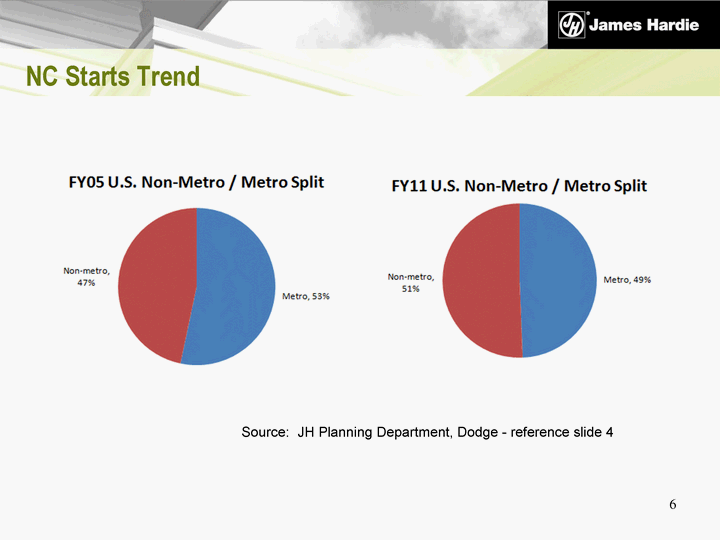
| NC Starts Trend 6 Source: JH Planning Department, Dodge - reference slide 4 6 |

| 7 Market Overview - Housing Characteristics Comparison Source: US Census Bureau, 2008 Characteristics of New Homes Survey Type SF (%) MF (%) Mobile home (%) Average Home Size (sf) Home Value (cost per square foot) % of Housing cost as a % of income Metro 59% 37% 4% 2,582 $88 24% Non-Metro 78% 7% 15% 2,203 $88 18% |
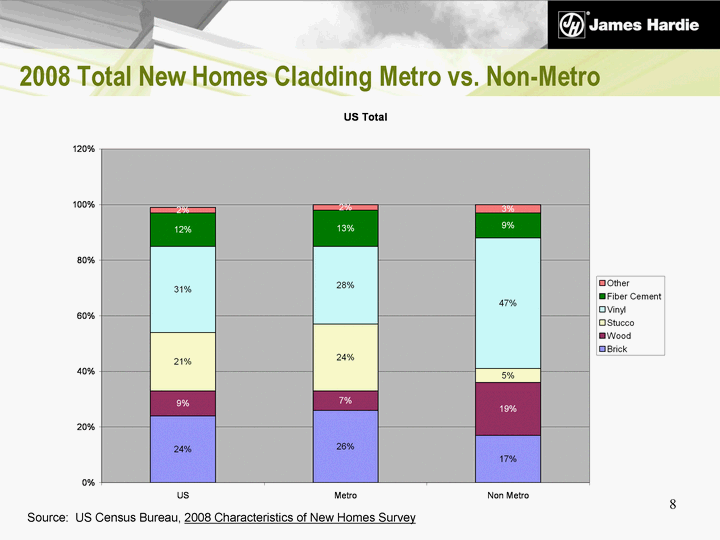
| 8 2008 Total New Homes Cladding Metro vs. Non-Metro Source: US Census Bureau, 2008 Characteristics of New Homes Survey |

| 9 New Homes By Builder Classification 69.5% Built for Sale (Land & House) Owners Built (home owner as GC) Non-Metro * 12.5% Contractor Built (builder or GC on owner's land) 18.0% Metro * US * Source: US Census Bureau, 2008 Characteristics of New Homes Survey * (JH Observation) % of total Homes built |
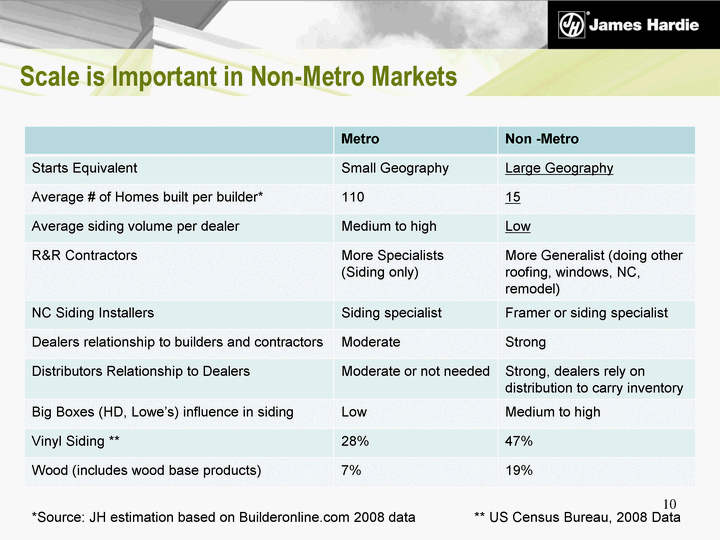
| Scale is Important in Non-Metro Markets Metro Non -Metro Starts Equivalent Small Geography Large Geography Average # of Homes built per builder* 110 15 Average siding volume per dealer Medium to high Low R&R Contractors More Specialists (Siding only) More Generalist (doing other roofing, windows, NC, remodel) NC Siding Installers Siding specialist Framer or siding specialist Dealers relationship to builders and contractors Moderate Strong Distributors Relationship to Dealers Moderate or not needed Strong, dealers rely on distribution to carry inventory Big Boxes (HD, Lowe's) influence in siding Low Medium to high Vinyl Siding ** 28% 47% Wood (includes wood base products) 7% 19% 10 *Source: JH estimation based on Builderonline.com 2008 data ** US Census Bureau, 2008 Data |
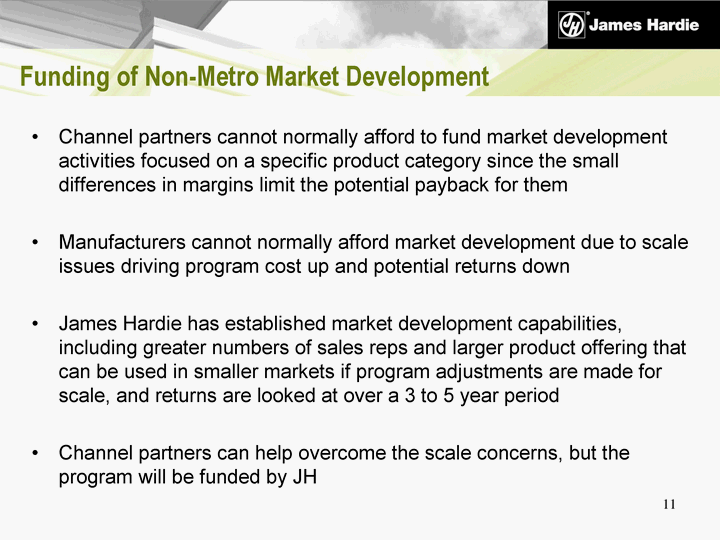
| Funding of Non-Metro Market Development Channel partners cannot normally afford to fund market development activities focused on a specific product category since the small differences in margins limit the potential payback for them Manufacturers cannot normally afford market development due to scale issues driving program cost up and potential returns down James Hardie has established market development capabilities, including greater numbers of sales reps and larger product offering that can be used in smaller markets if program adjustments are made for scale, and returns are looked at over a 3 to 5 year period Channel partners can help overcome the scale concerns, but the program will be funded by JH 11 |
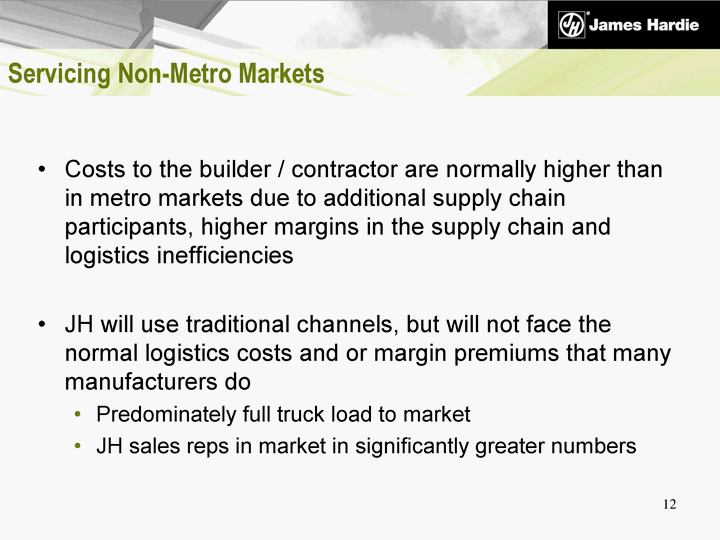
| Servicing Non-Metro Markets Costs to the builder / contractor are normally higher than in metro markets due to additional supply chain participants, higher margins in the supply chain and logistics inefficiencies JH will use traditional channels, but will not face the normal logistics costs and or margin premiums that many manufacturers do Predominately full truck load to market JH sales reps in market in significantly greater numbers 12 |

| Go Forward Plan |
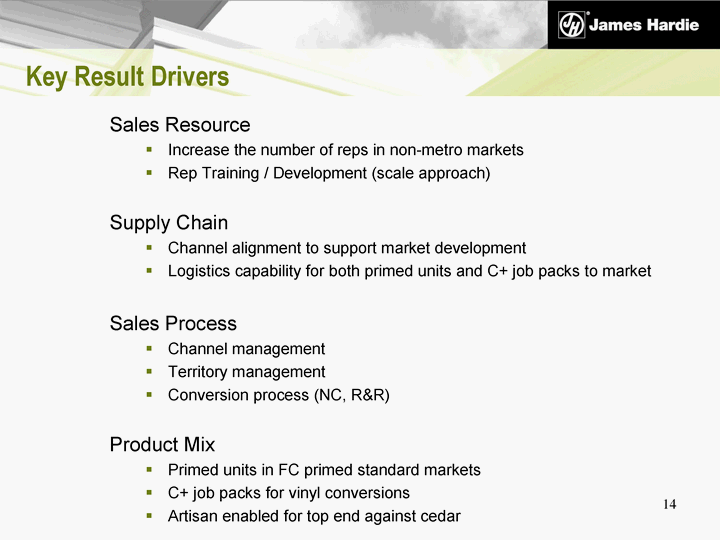
| Key Result Drivers Sales Resource Increase the number of reps in non-metro markets Rep Training / Development (scale approach) Supply Chain Channel alignment to support market development Logistics capability for both primed units and C+ job packs to market Sales Process Channel management Territory management Conversion process (NC, R&R) Product Mix Primed units in FC primed standard markets C+ job packs for vinyl conversions Artisan enabled for top end against cedar 14 |
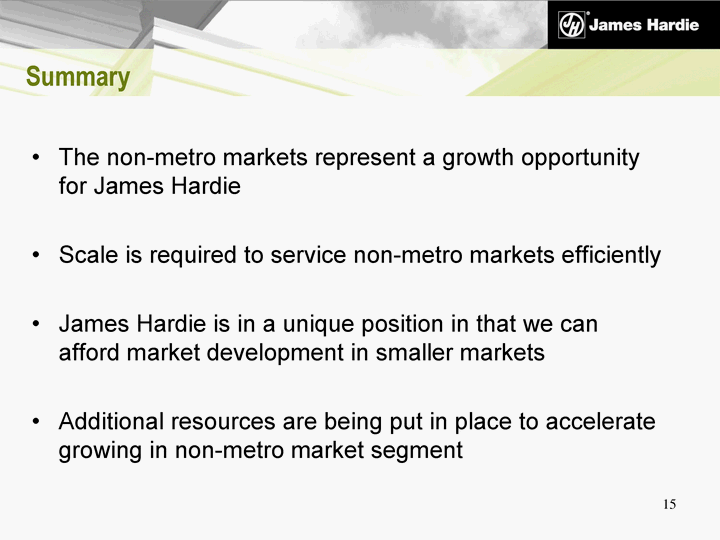
| Summary The non-metro markets represent a growth opportunity for James Hardie Scale is required to service non-metro markets efficiently James Hardie is in a unique position in that we can afford market development in smaller markets Additional resources are being put in place to accelerate growing in non-metro market segment 15 |

| Questions |